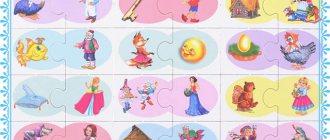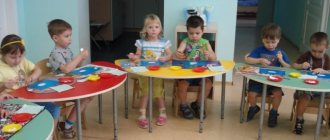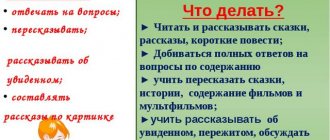Speech culture of a preschool teacher.
“YOUR SUCCESS IS YOUR SPEECH!”
Part I.
Requirements for the quality of speech of a preschool teacher
It is no coincidence that it is believed that a person’s speech is his calling card, since his success not only in everyday communication, but also in professional activities depends on how competently he expresses himself. This statement is especially relevant in relation to the speech of a teacher working with preschool children.
Reading an excerpt from a story
Mikhail Zoshchenko “Monkey tongue”
This Russian language is difficult, dear citizens! The trouble is, what a difficult one.
The main reason is that there are too many foreign words in it. Well, take French speech. Everything is good and clear. Keskose, merci, comsi - all, please note, purely French, natural, understandable words.
Come on, come on now with the Russian phrase - trouble. The whole speech is peppered with words with a foreign, vague meaning.
This makes speech difficult, breathing is impaired and nerves fray.
I heard a conversation the other day. There was a meeting. My neighbors started talking.
It was a very smart and intelligent conversation, but I, a person without a higher education, had difficulty understanding their conversation and flapped my ears.
The matter began with trifles.
My neighbor, not yet an old man with a beard, leaned over to his neighbor on the left and politely asked:
- What, comrade, will this be a plenary meeting or what?
“Plenary,” the neighbor answered casually.
“Look,” the first one was surprised, “that’s why I’m looking, what is it?” As if it were plenary.
“Yes, be calm,” the second one answered sternly. “Today it’s very plenary and the quorum has reached such a level - just hold on.”
- Yah? — asked the neighbor. “Have we really reached a quorum?”
“By God,” said the second.
- And what is this quorum?
“Nothing,” the neighbor answered, somewhat confused. “I got there, and that’s it.”
“Just tell me,” the first neighbor shook his head sadly. “Why would it be him, huh?”
The second neighbor spread his hands and looked sternly at his interlocutor, then added with a soft smile:
“You, comrade, probably don’t approve of these plenary sessions.” But somehow they are closer to me. Everything somehow, you know, comes out in them minimally to the essence of the day. Although I will say frankly that lately I have been quite permanent about these meetings. So, you know, the industry is going from empty to empty.
“This is not always the case,” the first objected. “If, of course, you look at it from the point of view.” To enter, so to speak, into the point of view and from the point of view, then yes - the industry specifically.
“Specifically, in fact,” the second one sternly corrected.
“Perhaps,” the interlocutor agreed. “I admit that too.” Specifically in fact. Although as when.
“Always,” the second one cut short. “Always, dear comrade.” Especially if after the speeches the subsection is brewing minimally. Discussions and shouting will not end then.
A man walked up to the podium and waved his hand. Everything fell silent. Only my neighbors, somewhat heated by the argument, did not immediately fall silent. The first neighbor could not come to terms with the fact that the subsection was welded minimally. It seemed to him that the subsection was brewed a little differently.
They shushed my neighbors. The neighbors shrugged their shoulders and fell silent. Then the first neighbor leaned over to the second again and quietly asked:
- Who is this guy who came out there?
- This? Yes, this is the presidium. A very sharp man. And the speaker is the first. He always speaks sharply on the essence of the day.
The speaker extended his hand forward and began speaking.
And when he uttered arrogant words with a foreign, vague meaning, my neighbors nodded their heads sternly. Moreover, the second neighbor looked sternly at the first, wanting to show that he was still right in the dispute that had just ended.
It is difficult, comrades, to speak Russian! 1925
Preschool age is a sensitive period for a child’s speech development, therefore one of the leading activities of a kindergarten teacher is the formation of oral speech and verbal communication skills, based on knowledge of the native literary language.
One of the main mechanisms for children to master their native language is imitation.
MM. Alekseeva notes that, imitating adults, the child adopts “not only all the subtleties of pronunciation, word usage, and phrase construction, but also those imperfections and errors that are found in their speech.”
That is why high demands are placed on the speech of a teacher in a preschool educational institution today, and the problem of improving the teacher’s speech culture is considered in the context of improving the quality of preschool education.
The quality of speech development of a preschooler depends on the quality of speech of teachers and on the speech environment that they create in a preschool educational institution.
Researchers such as A.I. Maksakov, E.I. Tikheyeva, E.A. Flerin, paid special attention to the creation of a developmental speech environment in kindergarten as a factor in the development of children’s speech. In their opinion, preschool workers should be charged with creating an environment in which “children’s speech could develop correctly and unhindered.”
In modern studies of the problems of improving the teacher’s speech culture, the components of his professional speech and the requirements for it are highlighted.
The components of a teacher’s professional speech include :
quality of language design of speech;
value and personal attitudes of the teacher;
communicative competence;
clear selection of information to create a statement;
orientation towards the process of direct communication.
Among the requirements for the speech of a preschool teacher are:
Correctness – compliance of speech with language norms. The teacher needs to know and follow the basic norms of the Russian language when communicating with children: orthoepic norms (rules of literary pronunciation), as well as norms for the formation and modification of words.
Accuracy is the correspondence between the semantic content of speech and the information that underlies it. The teacher should pay special attention to the semantic (notional) side of speech, which contributes to the development of children's skills of accurate word use.
Logicity is the expression in semantic connections of the components of speech and the relationships between the parts and components of thought. The teacher should take into account that it is in preschool age that ideas about the structural components of a coherent utterance are laid down, and the skills of using various methods of intratextual communication are formed.
Purity is the absence in speech of elements alien to the literary language. Elimination of non-literary vocabulary is one of the tasks of speech development in preschool children. When solving this problem, taking into account the leading mechanism of speech development of preschool children (imitation), the teacher needs to take care of the purity of his own speech: the use of filler words, dialect and slang words is unacceptable.
Expressiveness is a feature of speech that captures attention and creates an atmosphere of emotional empathy. The expressiveness of a teacher’s speech is a powerful tool for influencing a child. The teacher’s mastery of various means of expressive speech (intonation, tempo of speech, strength, pitch of voice, etc.) contributes not only to the formation of the arbitrary expressiveness of a child’s speech, but also to a more complete awareness of the content of an adult’s speech, and the formation of the ability to express his attitude to the subject of conversation.
Richness is the ability to use all linguistic units in order to optimally express information. The teacher should take into account that in preschool age the foundations of the child’s vocabulary are formed, therefore the rich vocabulary of the teacher himself not only helps to expand the child’s vocabulary, but also helps to develop his skills in the accuracy of word use, expressiveness and figurative speech.
Relevance is the use in speech of units that correspond to the situation and conditions of communication. The appropriateness of a teacher’s speech presupposes, first of all, having a sense of style. Taking into account the specifics of preschool age aims the teacher at developing a culture of speech behavior in children (communication skills, the ability to use various formulas of speech etiquette, focus on the communication situation, the interlocutor, etc.).
Of course, the teacher of a preschool educational institution’s knowledge of these requirements, their compliance and constant improvement of the quality of his speech is the key to the success of work on the speech development of children in preschool educational institutions.
What is speech culture?
First of all, this is the degree of proficiency in language norms (in the field of pronunciation, stress, word usage and grammar) as well as the ability to use all expressive means of language in different conditions of communication (communication) and in accordance with the goals set in the content of statements.
In addition, the culture of speech is a special linguistic discipline aimed at studying and improving the literary language as an instrument of national culture, the guardian of the spiritual wealth of the people.
Cultural speech is an essential element of a person’s general culture.
Part II.
Workshop “Test your literacy.”
The form of organization of teachers is small groups of 3-4 people.
Correct speech is the foundation of linguistic culture; without it there is and cannot be either literary artistic mastery or the art of the living and written word.
2.1 Grammatical correctness (green paper)
- Conjugate the verbs: run, want.
In what case is the form of the verb run used?
- Form the imperative form of the verbs:
Go – go (those); run - run(those); wave – wave (those), wave (those); sit down - sit down (those); lie down - lie down (those).
- Determine the gender of nouns and use the word in the correct form:
The windows are curtained (tulle)
Face hidden (veil)
The roof is being covered (tar paper)
Wash my hair (shampoo)
Head covered (shawl)
- Complete the sentences using the noun in the correct form:
I stood up, taking the child off my lap.
There are a lot of (apple trees), (cherries), (currants) in the garden.
The flu quarantine lasted 22 (days).
I bought all the gardening tools except (rakes).
2.2 Orthoepic correctness (blue paper)
- Place the emphasis and read the words: calling, more beautiful, pampering, pampering, spoiled, thinking, expert, money, plum, beets, cottage cheese, provision.
- Correctly use words in the genitive singular: bandage, pancake, cake, bow, goose.
- Correctly use words in the accusative case singular: board, river, cheek, beard, wall, harrow.
2.3. Vocabulary (pink paper)
- Correct sentence:
He is a complete ignoramus in matters of art.
The boy put on his coat and hat and went for a walk.
Kolya is the leading leader of our group.
When I returned back to my friends, everyone was very happy.
The conversation with the children came to its final end.
All children completed the assigned task on time.
The doctor prescribed medicine for the children.
- Synonymy. Explain the meanings of words. Make sentences with each of the words.
Old Ancient Old Old Ancient.
Having cited this series of synonyms-adjectives, the writer D.I. Fonvizin explained the semantic difference between them: “Old is what was new a long time ago; something that has been going on for a long time is called ancient. Something that has passed a long time is long ago. In the present usage, dilapidated is something that has decayed or collapsed due to old age. What is ancient is what happened in the most distant centuries.” To illustrate these meanings, D.I. Fonvizin gives the following continuation: “An old man usually likes to remember ancient incidents and talk about ancient customs; and if he is stingy, then you will find a lot of old things in his chests. There are as many of these examples now as there were in ancient times.”
So, the words included in the synonymous row mean approximately the same thing and at the same time not the same thing; they contain a common meaning for them, but different shades of it. It is the latter that play a role when using synonyms: they resemble the shades of paint in an artist, the nuances of sounds in a musician.
2.4. Spelling.
Vocabulary dictation: plasticine, art, applique, feel, charm, participate, safe, association, retelling, storytelling
Part III.
- Sayings of great people about speech (yellow paper).
“The word is one of man’s greatest weapons. Powerless in itself, it becomes powerful and irresistible when said skillfully, sincerely and on time” (A.F. Koni).
Tell me the word and I will tell you who you are! Socrates.
There are people who speak beautifully, but write far from it. This is because the place, the listener, etc. heats them up and draws out more from their minds than they could give without that heat. B. Pascal
Those who claim that they have a lot of thoughts in their heads, but cannot express them due to lack of eloquence, have not learned to understand themselves. M. Montaigne
Who among us doesn’t want to learn how to speak eloquently and convincingly! After all, the word accompanies us everywhere, and our language is a sign of intelligence or stupidity. Every intellectual profession is a speech one, therefore “the path in any career is strewn with the flowers of eloquence” (A.P. Chekhov).
He who keeps his mouth and his tongue keeps his soul from troubles.
From the Book of Solomon's Proverbs
Those who cannot speak will not make a career. Napoleon
- Reflection. “Unfinished sentence” technique.
Today's seminar helped me make sure...
Helped me complete my assignments...
During the seminar I was...
I rate the seminar...
Requirements for the quality of speech of a kindergarten teacher
Consultation for teachers of preschool educational institutions “Requirements for the quality of teacher speech.”
Author: Natalya Aleksandrovna Rogaleva, speech therapist. Place of work: MBDOU “Kindergarten “Masterok”, Abakan city. Goal: developing the competence of teachers in the requirements for the quality of speech of educators. A mandatory element of a person’s general culture is cultural speech. A person’s speech is his calling card, since his success not only in everyday communication, but also in professional activities depends on how competently he expresses himself. This statement is especially relevant in relation to the speech of a teacher working with preschool children. Cultural and methodological requirements for the teacher’s speech: strict compliance of the content of the teacher’s speech with the age of the children, their development, stock of ideas, based on their experience; teachers' possession of methodological skills, knowledge of the techniques necessary to exert an appropriate influence on children's speech, and the ability to apply them in all cases of communication with preschoolers, etc. Children learn to speak through hearing and the ability to imitate. Preschoolers say what they hear, since the internal mechanisms of speech are formed in a child only under the influence of systematically organized speech of adults. One of the main mechanisms for children to master their native language is imitation. That is why high demands are placed on the speech of a teacher in a preschool educational institution today, and the problem of improving the teacher’s speech culture is considered in the context of improving the quality of preschool education. Among the requirements for the speech of a preschool teacher are: • Correctness – compliance of speech with language norms. • Accuracy – correspondence between the semantic content of speech and the information that underlies it. • Logicity – expression in semantic connections of the components of speech and relationships between the parts and components of thought. • Cleanliness – elimination of non-literary vocabulary: the use of filler words, dialect and slang words is unacceptable. • Expressiveness is a feature of speech that captures attention and creates an atmosphere of emotional empathy (intonation, rate of speech, strength, pitch of voice). • Richness – the ability to use all linguistic units in order to optimally express information. • Relevance - the use in speech of units that correspond to the situation and conditions of communication. Taking into account the specifics of preschool age aims the teacher at developing a culture of speech behavior in children. The above requirements include the correct use of non-verbal means of communication by the teacher, his ability not only to speak with the child, but also to hear him. How can you ensure that your speech is expressive? Work on speech breathing and speech coherence. Speech breathing is different from ordinary vital breathing. The most correct way for speech is diaphragmatic-costal breathing, when inhalation and exhalation are performed with the participation of the diaphragm and intercostal muscles. When you inhale, the abdominal wall rises and the lower part of the chest expands. When you exhale, the abdominal and chest muscles contract. The inhale when speaking is short and light. Exhalation is long and smooth. Breathing should be easy and natural. Breathing development exercises: Initially, work is carried out on the development of long exhalation without the participation of speech. At the same time, it is important to ensure that the shoulders do not rise and that the muscles of the respiratory apparatus are not overstrained, so that the exhalation is smooth, gradual, and long. a) Sawing wood - you need to stand opposite each other in pairs, hold hands and imitate sawing wood: hands towards you - inhale, hands away from you - exhale. b) Warm up in the cold - inhale through the nose and blow on “chilled hands,” exhaling smoothly through the mouth, as if warming the hands. d) Blow out a candle, roll a pencil, blow on a turntable, blow up balloons, soap bubbles. After a smooth long exhalation has been formed, voice exercises are introduced: a) Echo - divided into two groups, one group is echo. The first group makes some sounds: a, u, o, the other quietly repeats. b) Blizzard - the plot picture “Blizzard” in front of the children. At the signal “The blizzard has begun”, the children hum quietly: oo-oo-oo... At the signal “Strong blizzard”, the children say loudly: oo-oo-oo... At the signal: The blizzard subsides - the children gradually reduce the strength of their voices. The blizzard is over - they fall silent. Strengthening correct breathing during speech. In order to develop speech breathing on a long, smooth exhalation, you can give special speech exercises: a) Flowers - place a bouquet of familiar flowers in a vase and name them. Then, one by one, they take out a flower, smell it, and pronounce the given phrase with one exhalation. The phrases gradually become more complex. For example: It smells good. Rose smells good. Rose smells very good. To develop and consolidate correct speech exhalation, you can use short poems by Alexandrova, Marshak, Barto. In this case, they first memorize the poem, and then take turns pronouncing one line of the poem on one exhalation. Working on the voice The main properties of the voice are: timbre, height, strength (loudness), flight. Timbre is the emotional coloring of a statement, expressing various feelings and giving speech various shades: surprise, sadness, joy. Exercises: 1) Say the interjection “O” with different intonations: surprised, happy, dissatisfied, scared. 2) Pronouncing words, expressing different feelings: open the door! - angry, tragic, sad, joyful, cheerful, irritated. 3) Read the poem in a different tone so that it becomes clear how the boy, his aunt, mother, and sister feel about football. Aunt said: -Football! (with disdain). Mom said: “Ugh, football!” (with disgust). My sister said: “Well, football!” (disappointed). And I answered: Wow, football! (enthusiastically). Voice pitch. Voices are naturally high, medium and low. Depending on the pitch of the sound, types of singing voices are distinguished. For men - bass, baritone, tenor; for women - contralto, mezzo-soprano, soprano; for children - alto, treble. Your natural voice fits one of these types. Each person can change the pitch of their voice. It is customary to distinguish between three registers (upper, middle and lower). Each voice is characterized by a certain range. To prevent the voice from becoming monotonous, it is necessary to expand the pitch range. Games and exercises to expand the range of sounds: 1. Say the sound U, imitating an ocean liner (low sound) and a small steamboat (high sound). 2.Pronounce the sound Zh with varying degrees of height, imitating the buzzing of a large bumblebee (low) and a small bee (high). 3. Remember what they said in the fairy tale “The Three Bears” - Mikhailo Ivanovich, Nastasya Petrovna and Mishutka. Say the phrase: “Who was sitting in my chair?” (high, medium, low). It is necessary to practice pronouncing phrases with the intonation of a statement, a question, an exclamation. It is necessary to expand the sound-pitch range in order to correctly pronounce proverbs and correctly ask riddles. Volume (voice strength). Volume is the controlled quality of the voice. It can and should be changed depending on various circumstances of communication. Flexible change in voice volume is a means of achieving expressiveness of speech and its diversity. The choice of one or another level of volume depends primarily on the communication situation (where you are talking, with whom, at what distance), on the purpose for which people enter into communication (if your goal is a confidential conversation, consolation, sympathy, then the speech will be quiet ), depends on the content of the speech (when talking about thunderstorms, military operations, etc., the volume is increased). Exercises for choosing an adequate volume: 1. “Hoot.” Imagine that you are lost in the forest. You stand and shout: AU-AU! You need to pronounce sounds quietly first, then louder, and then even louder. The more steps you master, the more volume you have. 2. The whistle of the locomotive: ooh (quietly, louder, louder). 3. “Field of Miracles”, Imagine that you are on the program “Field of Miracles” and you are asked to say: Commercial break! (Quiet, louder, louder). 4. Read the poem expressively: Silence. There was Silence, silence, silence... (Very quietly, almost in a whisper). Suddenly there was a roar of thunder! (Very loud). And now it’s raining quietly - you hear (quietly). It started creeping, creeping, creeping across the roof... (louder). He'll probably start drumming now (even louder). It's already drumming! It's already drumming! (loud). Voice flight is the ability of a voice to be heard over long distances with minimal effort from the speaker or singer. To give your voice flight, you need to: 1) Take the correct posture (straighten your shoulders, lift your chin), 2) Send the sound just above the listeners’ heads, as if diagonally upward. 3) Say the words loudly, stretching out the vowels, with a wide breath, very accurately collecting the sound on the lips. First, you can bring your cupped palms to your lips. Exercise: Stand in front of the group. Say "Aw" or "Fire". Imagine that the word seems to be flying diagonally, like a launched ball. Pronounce the words loudly, stretching out the vowels. Working on rhythm. The rhythm of speech is a uniform alternation of stressed and unstressed syllables, varying in duration and voice strength. This orderliness of speech makes speech melodic and musical. A clear rhythm is characteristic primarily of poetic speech. The rhythm can be different: fast, rapid and slow, smooth; tense, emotionally excited and calm, unhurried; chased, energetic as in a march, and flying, gliding, as in a waltz; monotonous and cheerful, lively, expressive. The rhythm is not chosen by the author of a work of art by chance. It depends on the content of the text, the nature of the events and characters depicted, and the author’s intention. Exercises to improve the sense of rhythm: 1. You are drummers. Beat out a marching march with a stick in the following rhythm. 2. You are a conductor. We pronounce the poem with the movement of the hand (stressed sound - hand from top to bottom, unstressed sound - from left to right). 3. Counting rhymes have a good rhythm, with the help of which they determine who will be the driver in the game (for example: The Greek was driving across the river) - by imitation. 4. Reading poetry with beating a rhythm with your palm on the table, on your knees: A hedgehog walks with a drum, Boom-boom-boom! The hedgehog plays all day long, boom-boom-boom! Working on tempo. Tempo is the speed at which speech is delivered. It can be accelerated or slowed down depending on the content and emotional coloring of the statement. To emphasize the semantic parts of a statement, as well as to separate one statement from another, pauses and stops are used in the flow of speech. In children's speech, pauses are often observed due to the immaturity of speech breathing and the child's inability to distribute speech exhalation in accordance with the length of the utterance. The pace can be fast, medium (moderate), slow. They differ in the length of the pauses. The choice of tempo is determined by: - the genre of the work, the content of the work (there are some passages that are read quickly or, for example, tongue twisters are always pronounced quickly), and the composition of the audience. Exercises to develop the ability to control the pace of speech: 1. Pronouncing the text with movements. 2. Pronouncing the text without moving. 3. Pronouncing tongue twisters at different paces - from slow to fast. Working on intonation Logical expressiveness is the most important condition for any type of speech. This includes: intonation - a set of sound elements of speech (includes melody (raising or lowering the voice, logical stress, pauses, tempo of speech, the main tone of the statement, rhythm). The melody of speech is the raising and lowering of the voice to express a statement, question, exclamation in a phrase Logical stress - highlighting the main meaning of the word in a phrase. The meaning of the phrase depends on the placement of logical stress, for example: Will you be at the theater today? Brother moved to a new apartment. Vera picked a lot of berries. (We pronounce sentences highlighting different words). Logical pauses - division phrases into meaningful segments. Each speech beat (syntagma) is separated from the other by stops of varying duration and fullness, which in texts often coincide with punctuation marks. If the pause is made incorrectly, the meaning of the statement can be distorted, and sometimes very significantly. Example: Execution cannot be pardoned. Games and exercises for highlighting pauses: 1. Absent-minded typesetter - one absent-minded typesetter typed a poem, what did he mess up? (Verse. B. Zakhoder) A very, very strange sight: The river outside the window is burning, Someone's house is wagging its tail, A dog is shooting from a gun, A boy almost ate a mouse, A cat with glasses is reading a book, An old grandfather flew into the window, A sparrow grabbed The grain will scream as it flies away: “That’s what a comma means!” (B. Zakhoder) 2. Depending on the location of the pause, the meaning of the statement changes. Pauses are indicated by a vertical line. What is the difference? How pleased he was with his friend's success! How pleased he was with his friend's success! Who is more correct? Pauses are often placed where there are punctuation marks in the written text - period, comma, dash, colon, semicolon. Read the sentences, pausing correctly. What, does it hurt? - What hurts? Well, shall we sing? - Well, what shall we sing? How did you finish? - How, did you finish? Working on diction. When expressively reading a literary text, good diction is important, i.e. clear, precise pronunciation of each sound. This way, the best speech audibility and understanding is achieved. This is especially important when working with preschoolers. Poor diction makes it difficult to listen, understand speech, and respond adequately to it. Check your pronunciation. To do this, record your speech on tape and listen to it several times. And then you yourself will decide what exercises are necessary to correct the shortcomings of your speech: “mumbling”, unclear pronunciation of some sound, “swallowing” the endings of words, etc. Consonants must be pronounced cleanly, easily, without excessive pressure, vowels - freely, vocally, loud enough. Proper emphasis of vowel sounds in speech makes it harmonious and pleasant to listen to. To improve diction, focusing on preschool listeners is of great importance: the desire to be understood by them, to interest them in the content of a literary work. It is necessary to remember: 1) The correct pronunciation of speech sounds depends on the work of the articulatory organs: lips, lower jaw, tongue, soft palate with a small tongue, larynx with vocal cords. Any violations of these organs will inevitably affect diction. Therefore, it is necessary to cure immediately any diseases of these organs. 2) Resonators of the chest cavity, larynx, pharynx, mouth, nasopharynx, and nose also participate in the formation of sounds. If one of the resonators is “closed” (for example, with a runny nose, breathing problems, etc.), the sound goes out, is distorted, becomes dull and unclear. To achieve clarity of pronunciation, it is necessary to develop the articulatory apparatus with the help of special exercises (articulatory gymnastics). Exercise 1. Say the proverbs, clearly highlighting each part. Then the task becomes more complicated: say the first part of the proverb loudly, the second quietly, then vice versa. As it comes back, so will it respond. Living with someone else's mind means no good. Don't have a hundred rubles, but have a hundred friends. Exercise 2. Imagine that you are playing the drum and your hands bounce easily with each stressed vowel in the word. A couple of drums, a couple of drums, A couple of drums, a couple of drums, A couple of drums, a couple of drums Beat, beat. Storm. The battle. (I. Selvinsky) Exercise 3. Practice the pronunciation of individual sounds by pronouncing tongue twisters and clearly highlighting the repeating sound. The saw squealed and the bee buzzed. Two woodcutters, two woodcutters, two wood splitters. Chitinka flows through Chita. Forty mice walked, carrying forty pennies, two smaller mice carried two pennies each. A good training for correct speech skills is reading poems that are characterized by internal and external organization. The strict alternation of stressed and unstressed syllables, the coordination of rhymed endings and the obligatory line pause give the verse verbal and musical organization: the speech is very rhythmic, melodic, each line leads to another line. When conducting classes with children, we must remember that a beautiful voice is one of the factors of a person’s attractiveness, one of his advantages. The sound of a voice can tell us a lot about its owner - about his character, thoughts, feelings, condition, attitude towards you. No wonder R.N. The proverb says: “Everyone will speak with his own voice.” We must remember this and work on the expressiveness of our speech and the speech of our children. Literature 1. Kalmykova I.R. "The Mysterious World of Sounds." Phonetic rhythm. 2. Methods of expressive reading, ed. Zavadskaya. 3. Rybnikov’s essays on the method of expressive reading. 4. Yazovitsky “Expressive reading as a means of aesthetic education.”
We recommend watching:
Essay by a kindergarten teacher. My educational philosophy. Essay by a preschool teacher. My pedagogical philosophy Summary of joint activities with children in the younger group Consultation for preschool teachers. Games for literacy classes for preschoolers
Similar articles:
Dance festival in kindergarten for children 5-7 years old. Scenario
Outdoor games as a means of harmonious development of a child
From work experience. Nurturing a culture of verbal communication in preschoolers
How to write a character reference for a child in kindergarten
Features of the intellectual development of preschool children
Logopant +
One of the components of a teacher’s skill is the culture of his speech.
Speech culture is knowledge of language norms of pronunciation, stress and word usage, as well as the ability to use expressive language means in different communication conditions in accordance with its purpose and content.
Cultural speech is an obligatory element of general culture, a person’s calling card, since success not only in everyday communication, but also in professional activities depends on how competently he expresses himself. This statement is especially relevant in relation to the speech of a teacher working with preschool children.
The quality of speech development of a preschooler depends on the quality of speech of teachers and on the speech environment that they create in a preschool educational institution.
For a kindergarten teacher, mastery of exemplary speech is an indicator of his professional preparedness. The culture of children’s speech depends on the teacher’s speech culture. The speech of the teacher, who is constantly in the field of view of the children, in communication with them, is the main source from which children receive a sample of their native language, cultural speech, therefore it must not only be correct, with a clear and distinct pronunciation of all the sounds of their native language, but and maintained at a certain tempo, volume, must be intonationally expressive, correctly grammatically formatted, coherent, understandable, with the correct and accurate use of verbal notations.
A story read by a teacher using expressive means will arouse children’s interest, make them empathize, feel the power of words, and remember the content for a long time; the same story, read dryly, at a fast pace, without emotion, can only cause boredom and indifference to the work of art.
The teacher must be self-critical of his own speech and, if there are shortcomings in it, strive to eliminate them. However, it is not always easy to establish and identify the shortcomings of one’s speech, since in the process of communication the speaker’s attention is drawn, first of all, not to the form of speech (how to say), but to its content (what to say). In addition, as a result of a long-term careless attitude to one’s speech, some shortcomings may become firmly entrenched and go unnoticed in the future. For example, such shortcomings as haste, slurred speech, monotony of speech, increased voice volume, inaccuracy in pronouncing individual sounds or words and other imperfections are not noticed.
To be aware of the imperfections of one’s own speech, the teacher needs to listen to comments from others. It is useful to record open lessons on video, so that during their analysis you can pay attention to the teacher’s speech, analyze its sound side, the use of lexical means, and grammatical formatting. Of course, you need to keep in mind that when recording on video, speech improves due to increased self-control. It is all the more important that manifested speech deficiencies become the subject of the teacher’s attention. The teacher notes detected imperfections in his speech (poor diction, violations in lexical and grammatical format, etc.) and thus organizes work to eliminate them.
In the studies of E.I. Tikheyeva, F.A. Sokhin and other founders of “Methods for the development of speech in preschool children” note that children learn to speak through hearing and the ability to imitate. Preschoolers say what they hear, since the internal mechanisms of speech are formed in a child only under the influence of systematically organized speech of adults.
Preschool age is a sensitive period for a child’s speech development, therefore one of the leading activities of a kindergarten teacher is the formation of oral speech and verbal communication skills, based on knowledge of the native literary language.
One of the main mechanisms for children to master their native language is imitation.
MM. Alekseeva notes that, imitating adults, the child adopts “not only all the subtleties of pronunciation, word usage, and phrase construction, but also those imperfections and errors that are found in their speech.”
That is why today high demands are placed on the speech of a teacher of a preschool educational institution, and the problem of improving the culture of a teacher’s speech is considered in the context of improving the quality of preschool education.
In modern studies of the problems of improving the teacher’s speech culture, the components of his professional speech and the requirements for it are highlighted.
The components of a teacher’s professional speech include:
- Competency in constructing phrases.
- competent pronunciation of words from everyday life: correct emphasis in words and the exclusion of local dialects.
- Simplicity and clarity of presentation: laconicism.
- Expressiveness:
- intonation and tonality;
- rate of speech, pauses;
— dynamics of voice sound;
- vocabulary richness;
- imagery of speech;
- diction.
- Correct use of technical terminology:
- exclusion of jarring phraseological phrases;
- exclusion of unnecessary words.
Among the requirements for the speech of a preschool teacher are:
- Correctness – compliance of speech with language norms. The teacher needs to know and follow the basic norms of the Russian language when communicating with children: orthoepic norms (rules of literary pronunciation), as well as norms for the formation and modification of words.
- Accuracy is the correspondence between the semantic content of speech and the information that underlies it. The teacher should pay special attention to the semantic (notional) side of speech, which contributes to the development of children's skills of accurate word use.
- Logicity is the expression in semantic connections of the components of speech and the relationships between the parts and components of thought. The teacher should take into account that it is in preschool age that ideas about the structural components of a coherent utterance are laid down, and the skills of using various methods of intratextual communication are formed.
- Purity is the absence in speech of elements alien to the literary language. Elimination of non-literary vocabulary is one of the tasks of speech development in preschool children. When solving this problem, taking into account the leading mechanism of speech development of preschool children (imitation), the teacher needs to take care of the purity of his own speech: the use of filler words, dialect and slang words is unacceptable.
- Expressiveness is a feature of speech that captures attention and creates an atmosphere of emotional empathy. The expressiveness of a teacher’s speech is a powerful tool for influencing a child. The teacher’s mastery of various means of expressive speech (intonation, tempo of speech, strength, pitch of voice, etc.) contributes not only to the formation of the arbitrary expressiveness of a child’s speech, but also to a more complete awareness of the content of an adult’s speech, and the formation of the ability to express his attitude to the subject of conversation.
- Richness is the ability to use all linguistic units in order to optimally express information. The teacher should take into account that in preschool age the foundations of the child’s vocabulary are formed, therefore the rich vocabulary of the teacher himself not only helps to expand the child’s vocabulary, but also helps to develop his skills in the accuracy of word use, expressiveness and figurative speech.
- Relevance is the use in speech of units that correspond to the situation and conditions of communication. The appropriateness of a teacher’s speech presupposes, first of all, having a sense of style. Taking into account the specifics of preschool age aims the teacher at developing a culture of speech behavior in children (communication skills, the ability to use various formulas of speech etiquette, focus on the communication situation, the interlocutor, etc.).
The above requirements include the correct use of non-verbal means of communication by the teacher.
Nonverbal communication culture of a teacher
Nonverbal communication is a non-verbal form that conveys figurative and emotional content and includes gestures, facial expressions, postures, eye contact and touch.
Non-verbal means are just as important as verbal ones. Research suggests that in a conversation, 45% of information is conveyed through words, and 55% through nonverbal means.
The nonverbal behavior of a teacher is associated with his mental states and serves as a means of expressing them. The main non-verbal means of communication include:
- facial expressions;
A special role in the transmission of information is given to facial expressions - movements of the facial muscles. Facial expressions express lived states and relationships. Studies have shown that if the teacher’s face is motionless, up to 10-15% of information is lost.
— expressiveness of body plasticity;
The teacher’s posture should be free, without tightness, psychological constraint, or “fossilism” (for example, a rigid stance with arms crossed on the chest).
THE MOST COMMON MISTAKES IN TEACHER SPEECH:
- Frequent use of words with diminutive suffixes;
- Using extra words in speech: well, that means this...
- Inappropriate use of onomatopoeic words;
- Errors in speech: “lay down” instead of “put down”, “beets” instead of “beets”, “come up with a word” instead of “name” and “remember”, “call” instead of “call”, etc.
Teacher speech culture rules:
1. The teacher should speak quietly, but so that everyone can hear him, so that the listening process does not cause significant stress in the students.
2. The teacher must speak clearly.
3. The teacher should speak at a speed of about 120 words per minute.
4. To achieve expressive sound, it is important to be able to use pauses - logical and psychological. Without logical pauses, speech is illiterate; without psychological pauses, speech is colorless.
- The teacher must speak with intonation, that is, be able to place logical emphasis, highlight individual words that are important for the content of what is being said.
6. Melody gives the teacher’s voice an individual coloring and can significantly influence the emotional well-being of students: inspire, captivate, calm. Melodics are born based on vowel sounds.
The culture of children’s speech depends on the teacher’s speech culture. With this in mind, the teacher should consider it a professional duty to continuously improve his speech in order to successfully work on the speech development of children.
Speech therapist of the first category Zotova G.G.








